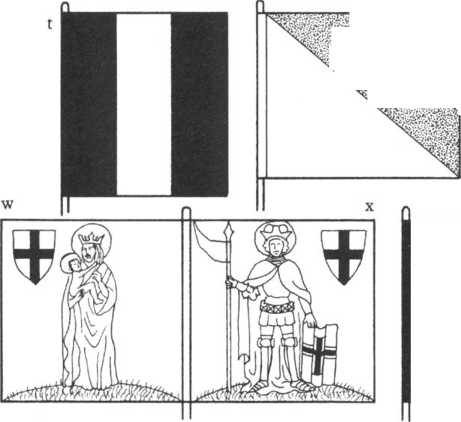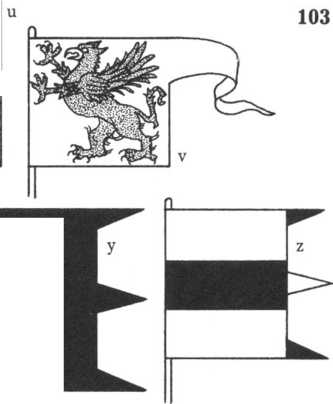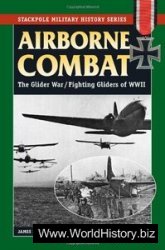It is clear from the sources that, regardless of their composition, Teutonic Knight armies were invariably organised under individual banners on the battlefield. To quote another passage from the ‘Livonian Rhymed Chronicle’: ‘After the native troops of Kurland and Semgallia had joined them, the Master and his advocates and the crusaders deemed it time to group the people under various banners, as is the custom in war. When they arrived at the frontier, the advocates regrouped their forces and drew them up for combat. The banners were entrusted to those who were eager for battle and who knew how to conduct themselves in such matters . .. Although there were many banners, the natives were so well-trained that they would not stray from their own.’
52 banners of the Order were captured at Tannenberg and hung in Krakow Cathedral, where they remained until 1940, when the Germans removed them to Marienburg after their occupation of Poland. As early as 1448 they were recorded by Jan Dlugosz, and drawn by Stanislaw Durink of Krakow, in a book entitled ‘Banderia Prutenorum’ {Banners of Prussia), from which this selection is taken.
103a is the ‘greater banner’ of the Order’s Hochmeister, who at the time of the battle was Fra Ulrich von Jungingen. It is white, with a gold cross outlined in black, and in the centre a gold shield charged with an eagle displayed sable. The hoist is blue, as are those of many of the flags depicted in Dlugosz’s book. In addition the Hochmeister also had a ‘lesser banner’, basically a smaller version of the flag depicted except that the hoist was white, the lower edge was not split into 3 tails, and there was no black bar across the ends of the cross arms, the gold inner cross instead reaching right to the edges of the flag. The ‘greater banner’ measured 70V4 inches x 52V4 inches, and the ‘lesser banner’ 29‘/4 inches x 23V2 inches. Probably they were both carried in the same division, Dlugosz’s reference to the Hochmeister leading under the ‘greater banner’ picked men from his council, plus brother knights, probably being an allusion to his bodyguard. Both flags seem to have actually been vexilla, suspended from a crossbar, as too were 103b, e and j.
103b is the banner of the Order, a simple black cross on white. This flag measured 76 V4 inches x 64V2 inches. At Tannenberg it was carried in the division commanded by Friedrich Wallenrod, Grand Marshal of Prussia and commander of the left wing.
103c is the flag of the Order’s ‘Company of St George’, under which German mercenaries in the employ of the Teutonic Knights were normally mustered, as they were at Tannenberg. Durink depicted this flag as a white cross on a red field with a short red tail, which was fairly certainly a mistake since Dlugosz elsewhere more plausibly describes the banner of St George as a red cross on white (see also 139c). The Teutonic Knights regarded St George as their patron saint, insisting that in their own land or service they

103
Alone had the right to bear his flag. This resulted in English crusading contingents being forbidden from unfurling their own flags of St George, as is recorded in 1364 and 1392.
103d is one of two banners of Kulm captured at the battle. Measuring 70 V4 inches X 74 inches (plus a tail 76‘/4 inches long), it is divided into wavy white and red bands, with a black border and cross at the top edge. The Swabian knight who carried this flag (Mikolaj or Nikolaus of Renys) was executed by Jungingen’s successor for — in Alan Nickel’s words — ‘displaying insufficient zeal in the battle’ (in fact he deserted). The second banner differed principally in having a white hoist, and its tail divided vertically into broad red and white stripes; in addition it was smaller, only about 49V4 inches long with a tail of 47 inches.
103e is the banner of the Order’s Grand Treasurer, who at the time of Tannenberg was Thomas Marcheim. Appropriately enough, his division included many mercenaries. The flag is red, with the key in white.
103f is the banner of the komturei of Stiihm, under which the Grand Commander, Kuno von Lichtenstein, fought with some brethren and many Austrian mercenaries — hence the flag, in Austria’s red-white-red colours, with a white hoist. A large flag, it measured ItVi inches X 70V4 inches. A similar flag, of slightly narrower proportions (64V2 inches x 49% inches) and with the stripes from top to bottom in red, white and black, with a blue hoist, was carried in the division of the advocate of Laski, the advocate of Hohenstein’s division having a very similar (but square) flag with the colours inverted. Yet another similar flag, this time measuring 64V2 inches X 58 inches and coloured green/white/red, with the white central band slightly wider than the others, plus a white hoist, was carried by a unit of German crusaders.
103g is the red and white banner, with a blue hoist, of the komturei of Elbing. This was the commandery of Werner von Thetingen, or Tetlingen, the Grand Hospitaller, who was the only one of the Order’s great officers to escape alive from the battle (being consequently disgraced for having fled the field). Dimensions were 41 inches X 26V2 inches. A second flag, under which Elbing’s vicekomtur fought, differed only in the crosses being formee rather than plain, while a third (the banner of the town of Elbing itself, under which the burgomeister led citizens and mercenaries) was identical to that depicted except in having the colours reversed, retaining the blue hoist. Curiously the ‘Banderia Prutenorum’ makes the flag of the vicekomtur’s division larger than that of von Thetingen’s — slightly more than half as big again — which means, presumably, that this was the komturei’s main flag (which implies that Dlugosz got them the wrong way round). That of the town was bigger again, measuring 70 V4 inches X 35 inches. Another similar flag captured in the battle was that of the town of Braunsberg, in which the crosses were again formee, black on white in the top half and white on black in the bottom half, with a grey hoist and measuring 41 inches X 29 V4 inches.
103h is the banner of the komturei of Konigsberg, the commandery of the Grand Marshal. At Tannenberg this division was led by the vice-marshal. The flag carries the royal arms of Bohemia (gules, a lion rampant queue fourchee and passed in saltire argent, armed and crowned or), conferred on the commandery by Jean de Luxembourg, king of Bohemia, whilst crusading in Prussia with the Order in 1329. The arms of the Order are displayed in chief, and the hoist is red. This flag measured about 49% inches x 70V4 inches (inclusive of schwenkel).
103i is the banner of the komturei of Balga, being white with a red wolf (with a black tongue) and a black top edge, which in fact may actually be the hoist (the flag possibly having been hung wrongly by its Polish captors). This measured 70V4 inches X 44 inches. A similar buj smaller banner (only a little over half the size of that depicted here) differed in its reversal of white and red, in addition to which the wolfs tail was shown down and the hoist was coloured blue; it was carried by a body of crusading Swiss knights, and it seems likely that they were attached to this commandery.
103j is the banner of the komturei of Graudenz, comprising a black bison’s or bull’s head on white, with yellow nostrils and eyebrows, and white eyes with red ‘bags’ under them. The nose-ring, horns and edges of the ears were mid-grey rather than black. This division was commanded by Wilhelm von Helfenstein.


103k is the black and white banner of the komturei of Althausen Hohe, this division being comprised at Tannenberg almost entirely of mercenaries. The banner of the komturei of Osterode differed only in the substitution of red for black and the addition of a white hoist. These two divisions were commanded by Wilhelm von Ippinburg and Konrad von Pinzenau respectively. Another flag, that of a unit of Misnian knights, had the quarters instead in red and blue, again with a white hoist, and measured 58 inches X 52% inches.
1031 is the banner of the komturei of Ragnit. It is white, with the 3 hats (blazoned by Dlugosz as pilei) in red. A second identical banner is attributed to the bishop of Sambia (Samland), men-at-arms and mercenaries of the bishopric fighting under it — but see next note. It seems likely that the pilei carried on both flags (also described as ‘mitres’ and ‘helmets’) were probably representations of Samogitian fur caps. Both flags measured 58 inches X 52V4 inches.
103m is attributed to the bishop of Kulmland, but is more likely to belong to the bishop of Sambia. It is white with a blue hoist and the sword and crook in red. It measured 44 inches X 52% inches.
103n is the banner attributed — probably wrongly — to the komturei of Schlochau. The lower portion is white, as is the hoist, with the agnus dei, goblet, halo and standard in white on a red background. It measured 52% inches x 41 inches, with a schwenkel of 47 inches. A very similar flag is more credibly recorded being carried at the head of a contingent provided by the bishop of Warmia (Ermland), though it differs in such subtle details as having a red hoist, a solid halo behind the lamb’s head, a flag which is wholly attached to the staff and bears a cross, a deeper white band, and a shorter schwenkel (35'A inches).
103o is one of two identical banners under which the men of the komturei of Danzig fought, one division being under the komtur, Johann von Schonfeld, the other being under the vicekomtur. It is white with a black diagonal band. They seem to have both measured 44 inches X 58 inches, with tails 47 inches long. The men sent by the town of Danzig, including a large number of hardbitten seamen, fought under a flag like that of the vicekomtur of Elbing described under 103g, differing only in both the crosses being white on an undivided red field.
103p is the banner of the komturei of Mewe, under which many German mercenaries fought under its commander, Johann, Graf von Wende. The arrows, one of them a bird-bolt, are in white on a red field. Virtually the same design, with the colours reversed, also appears on the flag of a unit of German crusaders, who were therefore probably attached to Mewe. The latter flag measured 47 inches square, 103p being slightly deeper and narrower.
103q is the banner of the komturei of Engelsburg, comprising a white angel, with brown hair, and face and hands proper, on a red field. Commander of this division was Burkhard Wobek, the Order’s Grand Drapier.
103r is the banner of the town and advocate of Heiligenbeil. It is black with a white axe and a white band at the top edge which, in another flag (that of the advocate of Bartenstein), extends into a schwenkel. The latter flag also differs in having no shaft above the socket of the axe, plus a blue hoist, and is also a few inches bigger than 103r, which was 47 inches square.
103s is the banner of the advocate of Brathian and Neumarkt, who was Johann von Redern. White with conjoined antlers in brown.
103t is the banner of the komturei of Nieszawa. The stripes are black/whiteAjlack. A similar flag, that of the advocate and town of Dirschau, had 4 stripes instead (black/white/black/white), plus a grey hoist, and measured 58 inches x 50 inches. Commanders of these two divisions were Gottfried von Hatzfeld and Matthias von Bebern.
103u is the banner of the komturei of Ortelsburg, led at the battle by its commander Albert von Eczbor. It is red over white, with a blue hoist, and measured 52V4 inches x 64% inches. A second, identical banner, differing only in having a white hoist and being 3 inches shorter is also depicted in Dlugosz’s book, having been captured at the Battle of Koronowo on 10 October 1410, where the new Hochmeister, Henry von Plauen, was defeated by a Polish army allegedly only half the size of his own.
103v is the banner of one of the Order’s Polish allies at Tannenberg, belonging to Casimir V, duke of Stettin in Pomerania, who led 600 men-at-arms and was taken prisoner. It is white, with a blue hoist and a red griffin with yellow talons and beak, and measured 41 inches X 44 inches. See also 139n and p.
The last 3 flags are all Livonian banners captured at the Battle of Nakel in 1431. 103w and x depict both sides of the Landmeister of Livonia’s flag, comprising on the one side a negro St Maurice in blued steel armour, and white cloak and surcoat on a white background, with his halo, crown, belt, lance, poleyns and couters all in gold, and on the other side the Livonian Mother of God device, with Mary in a blue gown over a white shift, the haloes and crown in gold, the flesh and hair proper, all on a white background. The escutcheons and St Maurice’s shield bear the arms of the Order, and both figures stand on green grass. This flag measured 41 inches square. 103y is black with the stars in white, and is possibly the banner of either the komturei of Ascheraden or that of Dunaburg, since both their commanders fought under it. Similarly, the black and white flag depicted in 103z might belong to either the komturei of Fellin or of Kurlanth, though a second, identical flag captured at the battle was carried in a division commanded by the advocate of Kokenhausen. 103z was 47 inches X 50V2 inches with tails of 23V2 inches, its counterpart being smaller.




 World History
World History









